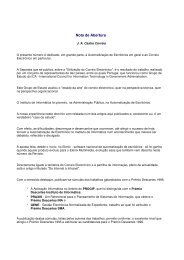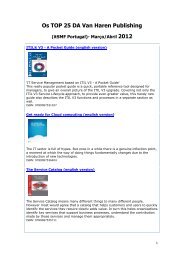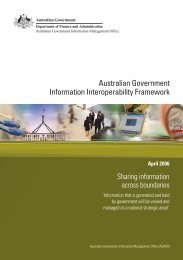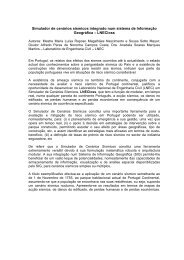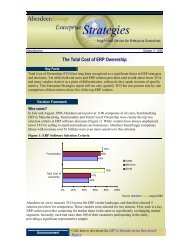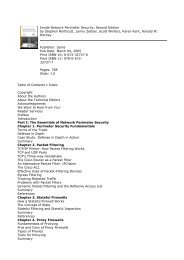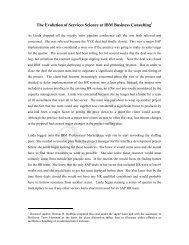OECD Peer Review of E-Government in Denmark - ePractice.eu
OECD Peer Review of E-Government in Denmark - ePractice.eu
OECD Peer Review of E-Government in Denmark - ePractice.eu
Create successful ePaper yourself
Turn your PDF publications into a flip-book with our unique Google optimized e-Paper software.
Alongside the problem <strong>of</strong> the reliability <strong>of</strong> measurement data there is a second problem relat<strong>in</strong>g<br />
to specification <strong>of</strong> the measures themselves. For example, <strong>Denmark</strong>’s e-government strategy is notable<br />
for establish<strong>in</strong>g an economic goal <strong>of</strong> releas<strong>in</strong>g resources for use elsewhere <strong>in</strong> government. As already<br />
noted, it states that at least 75% <strong>of</strong> digitalisation projects should release resources and at least 25%<br />
should do so to a great extent. However, there is no clarity over what is meant by “release resources”,<br />
and even less about what is meant by “a great extent”. Coupled with the fact that organisations are left<br />
to report their own achievements aga<strong>in</strong>st this goal, the lack <strong>of</strong> specificity <strong>of</strong> these measures creates the<br />
potential for lower performance than is expected by the <strong>Government</strong>, and/or disputes over the level <strong>of</strong><br />
actual achievements.<br />
Political and adm<strong>in</strong>istrative leadership<br />
At the whole-<strong>of</strong>-government level, <strong>Denmark</strong> is provid<strong>in</strong>g strong leadership for e-government, and<br />
<strong>of</strong>ficials express high levels <strong>of</strong> approval and satisfaction with the way e-government responsibilities<br />
are structured and co-ord<strong>in</strong>ated. The Jo<strong>in</strong>t Board <strong>of</strong> e-<strong>Government</strong>’s approach <strong>of</strong> br<strong>in</strong>g<strong>in</strong>g together<br />
top-level leaders from each level <strong>of</strong> government to take responsibility for a matter <strong>of</strong> cross-cutt<strong>in</strong>g<br />
<strong>in</strong>terest has been an <strong>in</strong>novation <strong>in</strong> Danish government that appears to have paid <strong>of</strong>f. The <strong>in</strong>terface<br />
between political and adm<strong>in</strong>istrative leadership is ensured by the relationship between the Board and<br />
m<strong>in</strong>isters <strong>in</strong> the <strong>Government</strong> F<strong>in</strong>ance Committee, who seem to be work<strong>in</strong>g well together <strong>in</strong> address<strong>in</strong>g<br />
e-government issues at the national political level.<br />
At an adm<strong>in</strong>istrative level, the Digital Task Force and IT-Policy Centre are seen as effective<br />
leaders, facilitators and co-ord<strong>in</strong>ators <strong>of</strong> e-government. The Digital Task Force has been successful <strong>in</strong><br />
act<strong>in</strong>g as a catalyst to br<strong>in</strong>g <strong>in</strong>terested parties together to solve problems <strong>of</strong> co-ord<strong>in</strong>ation and<br />
collaboration across the levels <strong>of</strong> the public sector, and its use <strong>of</strong> staff temporarily seconded from<br />
other organisations has proven to be effective <strong>in</strong> spread<strong>in</strong>g awareness and best practices. Its role and<br />
expertise have been well complemented by the IT-Policy Centre <strong>in</strong> the MVTU, which has played an<br />
important role <strong>in</strong> the development <strong>of</strong> enablers <strong>of</strong> e-government (e.g. the digital signature, enterprise<br />
architecture and technical standards) and connect<strong>in</strong>g these to wider government ICT policies.<br />
Proposals for action<br />
9. The Danish e-government vision and strategy has played an important role <strong>in</strong> guid<strong>in</strong>g the<br />
e-government efforts <strong>of</strong> <strong>in</strong>dividual government organisations, and provid<strong>in</strong>g a platform for the leadership and<br />
co-ord<strong>in</strong>ation <strong>of</strong> e-government. The strategy is scheduled to be achieved by the end <strong>of</strong> 2006, and any plans to<br />
cont<strong>in</strong>ue with a national e-government strategy beyond this po<strong>in</strong>t have not been announced. The <strong>Government</strong><br />
should consider whether a further iteration <strong>of</strong> the e-government strategy would be beneficial <strong>in</strong> terms <strong>of</strong> achiev<strong>in</strong>g<br />
both e-government and wider policy goals and, if warranted, what the focus <strong>of</strong> a renewed strategy would be.<br />
10. The structure <strong>of</strong> e-government leadership and co-ord<strong>in</strong>ation, based on the pivotal roles <strong>of</strong> the<br />
<strong>Government</strong> F<strong>in</strong>ance Committee, the Jo<strong>in</strong>t Board <strong>of</strong> e-<strong>Government</strong>, the Danish Digital Task Force, and the<br />
IT-Policy Centre, is well established and proven to be a key success factor for e-government <strong>in</strong> <strong>Denmark</strong>. The<br />
<strong>Government</strong> should take this <strong>in</strong>to account <strong>in</strong> mak<strong>in</strong>g decisions on what k<strong>in</strong>d <strong>of</strong> central leadership, if any, is<br />
needed to support e-government beyond 2006.<br />
11. The Danish e-government strategy is notable for the explicit measures it sets out for assess<strong>in</strong>g<br />
achievement <strong>of</strong> its goals, particularly with regard to e-government deliver<strong>in</strong>g measurable f<strong>in</strong>ancial benefits.<br />
However, it is not clear that current approaches to measurement <strong>of</strong> the achievement <strong>of</strong> these goals will be reliable<br />
or verifiable. To ensure this clarity, and avoid creat<strong>in</strong>g confusion and concern among organisations that are<br />
subject to these goals, more robust means <strong>of</strong> measurement should be developed.<br />
14



